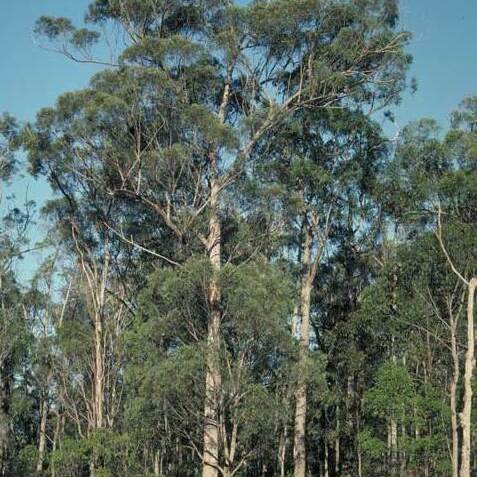Tree to 25 m tall. Forming a lignotuber. Bark rough to small branches, stringy or fibrous, grey or grey-brown. Juvenile growth (coppice or field seedlings to 50 cm): stems round in cross-section; juvenile leaves opposite, sessile and amplexicaul at first, then petiolate and alternate by 6 to 12 nodes, ovate, 8–20 cm long, 3.5–10 cm wide, discolorous, green, lamina held horizontally; eventually becoming lanceolate, concolorous, blue-green and held vertically.Adult leaves alternate, petiole 1–2 cm long; blade lanceolate or falcate, 8–17 cm long, 1.7–4 cm wide, base usually oblique, concolorous to weakly discolorous, dull, blue-green, side-veins usually greater than 45° to midrib, moderately to densely reticulate, intramarginal vein parallel to and well-removed from margin, oil glands mostly island.Inflorescence occasionally terminal compound, more often axillary unbranched, peduncles 1–2.2 cm long, buds in umbels of 7, 9 or 11 per umbel, pedicels 0.3–0.7 cm long. Mature buds buds fusiform or ovoid (0.6–0.7 cm long, 0.3–0.4 cm wide), scar absent, operculum conical to slightly beaked, stamens irregularly flexed, anthers reniform to cordate, versatile, dorsifixed, dehiscing by confluent slits, style long, stigma tapered, locules 3 or 4, the placentae each with 2 vertical ovule rows. Flowers white.Fruit pedicellate (pedicels 0.2–1 cm long), cup-shaped, hemispherical or truncate-globose, 0.3–0.7 cm long, 0.5–0.8 cm wide, disc narrow, usually level or weakly descending or weakly raised, valves 3 or 4, near rim level.Seeds brown, 1–1.5 mm long, pyramidal or obliquely pyramidal, dorsal surface smooth, hilum terminal. Cultivated seedlings (measured at ca node 10): cotyledons reniform; stems rounded in cross-section; leaves opposite for at least 10 nodes, sessile at lower nodes but becoming shortly petiolate, ovate-lanceolate, 8–12 cm long, 3.5–6 cm wide, base amplexicaul to lobed or tapering, discolorous, darker green and glossy above.
More
Tree to 25 m. Adult leaves: lamina 8–12 cm long, 2.5–4 cm wide, blue-green; lateral veins faint or just visible, at 35°–50°; intramarginal vein up to 2 mm from margin; petiole 10–20 mm long. Peduncle terete, 10–20 mm long; pedicels 4–5 mm long. Operculum 3–4 mm long and wide; hypanthium hemispherical, 3–4 mm long and wide. Fruits 6–7 mm long, 5–7 mm wide; disc narrow, descending.


